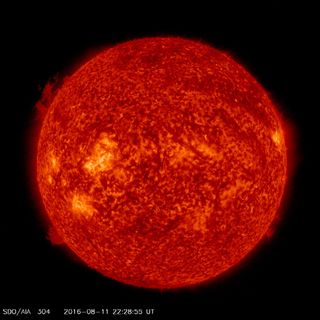'We Don't Planet' Episode 1: What's the Structure of the Sun?

The interior of the sun has layers like a very, very hot onion. In the core, the incredible gravitational pressures overwhelm the usual electric repulsion of protons, shoving hydrogen atoms together to form helium. The newly forged helium atoms have slightly less mass than the original hydrogen, and that little bit of mass gets released as highly energetic bits of light, or photons.
Just outside the fusion core, the massive number of photons dominates the physics: energy from the core is transported outwards directly by the radiation itself — hence the name "radiative zone."
Farther out, however, the density of photons drops and less exotic energy transfers take over. In this convective zone, huge plumes of plasma are heated from below, become buoyant, and rise higher up. Like a vast pot of boiling water, when the plumes reach the surface they cool, increase in density, and slip back down, only for the process to be repeated again. This process breaks the surface of the sun into Earth-sized convection cells, visible through specialized telescopes.
It’s at this surface, the photosphere, where light can travel freely and escape into space, but it’s not the edge of the sun. Beyond this layer sits the corona, a think tenuous plasma that stretches almost twice the radius of the photosphere. The corona is incredibly hot — over 1 million degrees Kelvin — but so thin that you could travel through it without notice. Usually the glow of the corona is observed by the intensity of the photosphere, but it can be seen during solar eclipses, or with the aid of artificial coronagraphs.
We Don’t Planet is hosted by Ohio State University astrophysicist and COSI chief scientist Paul Sutter with undergraduate student Anna Voelker. Produced by Doug Dangler, ASC Technology Services. Supported by The Ohio State University Department of Astronomy and Center for Cosmology and AstroParticle Physics. You can follow Paul on Twitter and Facebook.
Get the Space.com Newsletter
Breaking space news, the latest updates on rocket launches, skywatching events and more!
Join our Space Forums to keep talking space on the latest missions, night sky and more! And if you have a news tip, correction or comment, let us know at: community@space.com.

Paul M. Sutter is an astrophysicist at SUNY Stony Brook and the Flatiron Institute in New York City. Paul received his PhD in Physics from the University of Illinois at Urbana-Champaign in 2011, and spent three years at the Paris Institute of Astrophysics, followed by a research fellowship in Trieste, Italy, His research focuses on many diverse topics, from the emptiest regions of the universe to the earliest moments of the Big Bang to the hunt for the first stars. As an "Agent to the Stars," Paul has passionately engaged the public in science outreach for several years. He is the host of the popular "Ask a Spaceman!" podcast, author of "Your Place in the Universe" and "How to Die in Space" and he frequently appears on TV — including on The Weather Channel, for which he serves as Official Space Specialist.
